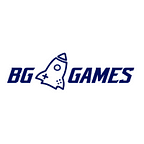The video game industry is a booming colossus, with global revenue reaching a staggering $184.4 billion in 2023. From the pixelated pioneers of the Atari era to the hyper-realistic landscapes of today’s AAA titles, crafting a successful game requires a potent concoction of creative brilliance, innovative technology, and meticulous planning. However, in this whirlwind of development, a crucial ingredient often gets relegated to the backburner: marketing promotion. So let’s diverse into that interesting and important field with BG Games!
The Golden Age of Arcades: A Time When Games Marketed Themselves
The early days of video games were a simpler time. Arcade cabinets were captivating spectacles in themselves, their vibrant colors, flashing lights, and booming soundtracks drawing players in like moths to a flame. Games like Pac-Man and Space Invaders didn’t need flashy marketing campaigns; their addictive gameplay and iconic characters were their own best advertisements. Word-of-mouth spread like wildfire, with high scores and tales of epic battles fueling the gaming fire.
The Rise of Home Consoles and the Dawn of Marketing Strategies
As video games transitioned from arcades to living rooms with the advent of home consoles like the Atari 2600 and Nintendo Entertainment System (NES), the landscape began to shift. Competition intensified, and developers needed a way to stand out in a crowded marketplace. This period saw the birth of early marketing strategies. Print ads in gaming magazines, catchy commercials featuring pixelated mascots, and even bundled game demos on cereal boxes became commonplace.
The Marketing Arms Race: Blockbusters and Budgetary Battles
The industry’s exponential growth in the late 20th and early 21st centuries ushered in an era of marketing extravagance. With blockbuster titles vying for dominance, publishers started allocating massive budgets for promotional campaigns. Cinematic trailers boasting Hollywood-level visuals, elaborate influencer marketing strategies, and celebrity endorsements became the norm. The 2013 marketing campaign for Grand Theft Auto V, estimated to be around $100 million, serves as a prime example of this period’s marketing arms race.
The Double-Edged Sword of Hype: When Marketing Overshadows Gameplay
While these aggressive marketing campaigns could undoubtedly generate immense hype, a critical question arose: was the focus shifting from the game itself to the marketing spectacle surrounding it? Cases like No Man’s Sky, whose pre-release trailers promised a vast, explorable universe, only to deliver a more limited experience at launch, highlighted the dangers of overpromising through marketing. Players grew increasingly wary of marketing hype, leading to a backlash against practices perceived as misleading or manipulative.
The Rise of Digital Marketing and the Power of Community Engagement
The digital revolution brought about a paradigm shift in marketing strategies. Social media platforms like Twitter, YouTube, and Twitch became powerful tools for developers to connect directly with their audience. Livestreaming gameplay demos, fostering community engagement through developer Q&A sessions, and leveraging influencer marketing on a more organic level became prevalent. Titles like Minecraft, with its strong online community fostered through social media and user-generated content, showcased the power of this new approach.
The Indie Renaissance: A Focus on Innovation and Authentic Marketing
The rise of independent game development studios has also reshaped the marketing landscape. Indie developers, often with limited budgets for traditional marketing, have embraced a more creative and audience-focused approach. Engaging concepts like “dev logs” that provide players with behind-the-scenes glimpses into game development, participation in online game jams, and fostering a sense of community ownership through early access programs are helping indie titles carve a niche for themselves.
Finding the Marketing Sweet Spot: Balancing Creativity with Efficiency
So, what does it take to craft a successful marketing campaign in today’s ever-evolving video game industry? The answer lies in striking a delicate balance. Developers must move beyond the “spray and pray” approach of yesteryear and create targeted campaigns that resonate with their specific audience. Authenticity is key — showcasing the genuine passion behind the game resonates far more than hollow promises.
Case Study: The Marketing Masterclass of Stardew Valley
Stardew Valley, a charming pixelated farming simulator developed by Eric Barone (ConcernedApe), serves as a testament to the power of well-executed marketing. Barone relied heavily on social media, actively engaging with his audience throughout the development process. He fostered a sense of community through forums and Q&A sessions, building a strong foundation of trust and anticipation. When the game finally launched, it wasn’t met with a flashy marketing blitz. It was the organic excitement of a passionate community that propelled it to success.
Marketing — Not Just a Box-Ticking Exercise
The video game industry is a vibrant ecosystem where creativity and commerce converge. While innovative gameplay and captivating narratives are undoubtedly the foundation of a successful game, neglecting marketing promotion is a recipe for lost potential. Effective marketing goes beyond creating a buzz, it’s about fostering a genuine connection with the target audience.
The industry has come a full circle. From the self-advertising glory days of arcade cabinets to the overhyped marketing spectacles of the blockbuster era, developers are now rediscovering the power of authenticity and targeted communication. By embracing new avenues for audience engagement, prioritizing community building, and ensuring that marketing accurately reflects the game’s core experience, developers can ensure that their creations reach the players who will cherish them most.
In the ever-evolving world of video games, marketing is not just a box-ticking exercise, it’s an ongoing conversation with the passionate community that fuels the industry’s growth. By striking the right balance between creativity and efficiency, developers can ensure that their games not only generate excitement but also deliver an experience that lives up to the hype, leaving a lasting impression on players for years to come!
